Children often experience various skin conditions that can cause discomfort and concern. Understanding these common issues can help parents identify symptoms early and seek appropriate care. Here are ten prevalent skin conditions in children:
1. Atopic Dermatitis (Eczema)
Atopic dermatitis, commonly known as eczema, is a chronic inflammatory skin condition characterised by itchy, red, swollen, and cracked skin. Clear fluid may come from the affected areas, which can thicken over time. The exact cause is unknown but is believed to involve a combination of genetic, immune system, and environmental factors. Children with a family history of eczema, hay fever, or asthma are at a higher risk. Environmental factors such as living in urban areas or dry climates may also increase the likelihood of developing the condition. citeturn0search10
Symptoms include severe itching, red to brownish-grey patches, small raised bumps that may leak fluid, thickened or scaly skin, and raw, sensitive areas caused by scratching. In infants, eczema often appears on the scalp and face, particularly on the cheeks, while older children and adults commonly experience it in the creases of the elbows and knees, as well as the neck, wrists, and ankles
Diagnosis is primarily clinical, based on the patient’s history and physical examination. The UK Diagnostic Criteria require itchy skin plus three or more of the following: involvement of skin creases, personal or family history of asthma or allergic rhinitis, generally dry skin within the past year, onset before age two, and visible flexural eczema. Treatment focuses on managing symptoms through regular use of moisturisers to maintain skin hydration, topical corticosteroids to reduce inflammation and itching, and identifying and avoiding triggers that worsen symptoms. In severe cases, systemic medications or phototherapy may be considered.
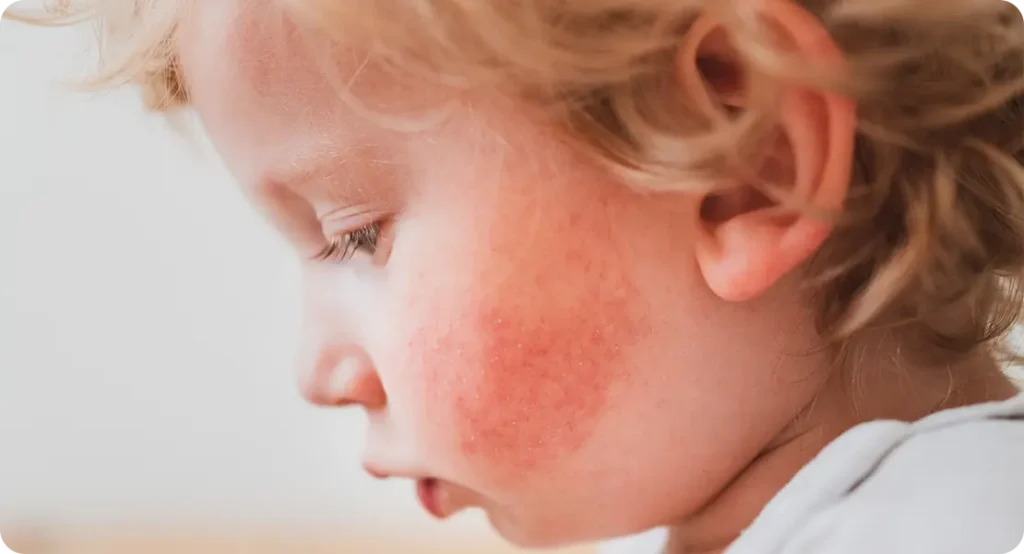
2. Impetigo
Impetigo is a highly contagious bacterial skin infection predominantly affecting infants and young children. It manifests as red sores or blisters, primarily around the nose and mouth, which rupture and form characteristic golden-yellow crusts. The condition is primarily caused by Staphylococcus aureus and sometimes by Streptococcus pyogenes. Risk factors include attending daycare, crowded living conditions, poor nutrition, diabetes mellitus, contact sports, and breaks in the skin such as from insect bites, eczema, scabies, or herpes.
Treatment typically involves topical antibiotics like mupirocin or fusidic acid for localized infections. More extensive cases may require oral antibiotics such as dicloxacillin, flucloxacillin, or erythromycin. Maintaining good hygiene, including regular handwashing and avoiding sharing personal items, is crucial to prevent the spread of impetigo. Children with impetigo should be kept out of school or daycare until they have been on antibiotics for at least 24 hours and their sores are covered.
3. Molluscum Contagiosum
Molluscum contagiosum is a common viral skin infection in children, caused by the molluscum contagiosum virus (MCV), a member of the poxvirus family. It presents as small, firm, flesh-coloured papules with a characteristic central dimple. These lesions are typically painless but may become itchy or irritated. They commonly appear on the face, trunk, limbs, and, less frequently, the genital area. The virus spreads through direct skin-to-skin contact, contact with contaminated objects like towels, or autoinoculation by scratching or picking the lesions and then touching other parts of the skin. Children with weakened immune systems, atopic dermatitis, or those living in crowded conditions are at higher risk.
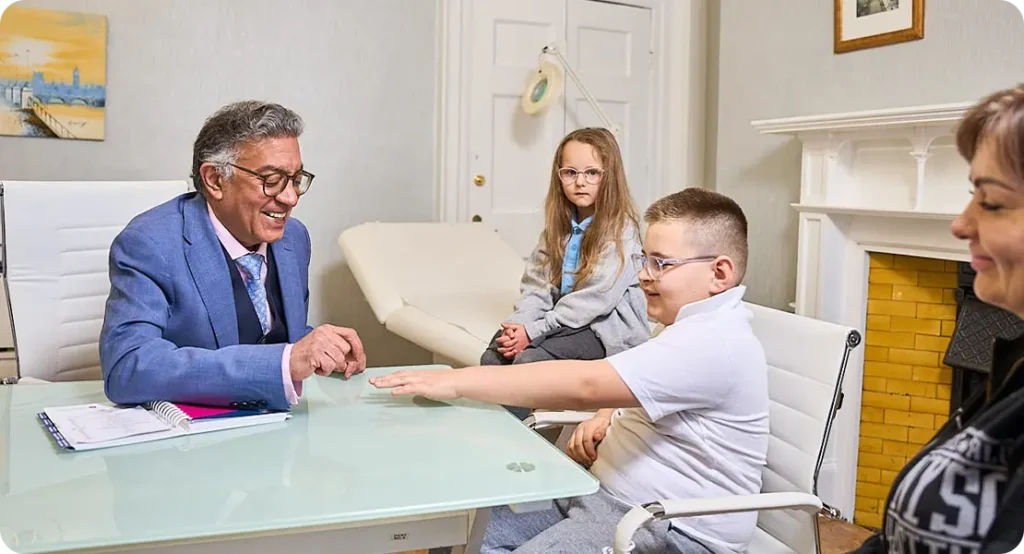
While molluscum contagiosum is generally self-limiting, with lesions resolving within six to twelve months without treatment, some cases may persist longer, especially in immunocompromised individuals. Treatment is often unnecessary unless lesions are symptomatic, cosmetically concerning, or to prevent transmission. Options include topical therapies, cryotherapy, curettage, or laser therapy. However, these treatments can cause discomfort and potential scarring, and there is limited evidence that they are more effective than natural resolution. Preventive measures include maintaining good hygiene, avoiding sharing personal items, and covering lesions to reduce the risk of spreading the virus to others.
4. Tinea (Fungal Infections)
Tinea refers to a group of superficial fungal infections affecting various parts of the body, each named according to its location. Tinea capitis involves the scalp, leading to scaly patches and potential hair loss. Tinea corporis, commonly known as ringworm, presents as circular, red, scaly lesions on the skin. Tinea pedis, or athlete’s foot, affects the feet, causing itching, scaling, and sometimes blistering. These infections are primarily caused by dermatophytes—fungi that thrive on keratinized tissues like skin, hair, and nails. Transmission occurs through direct contact with infected individuals, animals, or contaminated objects such as towels and floors.
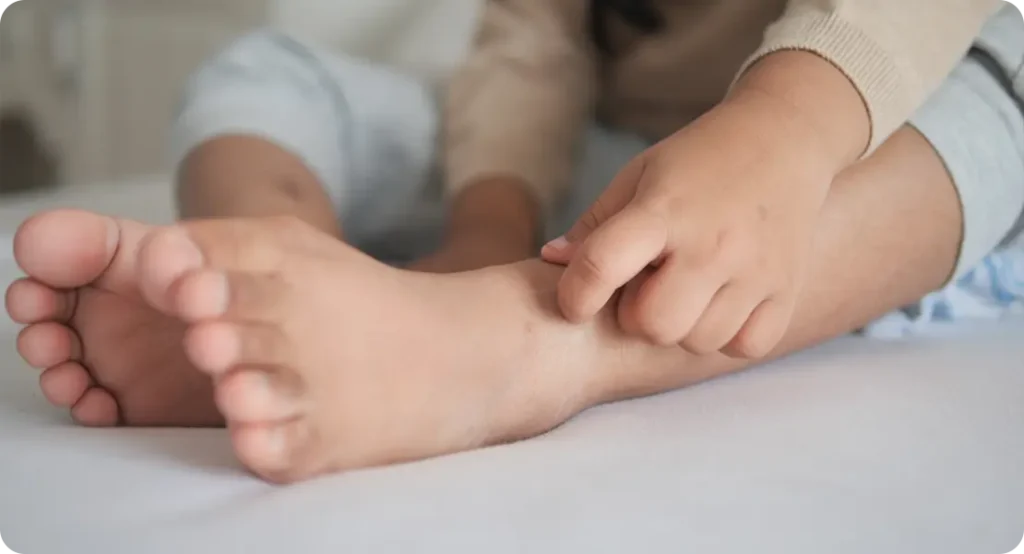
Treatment typically involves the application of topical antifungal agents like clotrimazole or miconazole. For more extensive or resistant infections, oral antifungal medications such as terbinafine or fluconazole may be prescribed. Preventive measures include maintaining good hygiene, keeping the skin dry, avoiding walking barefoot in communal areas, and not sharing personal items. Early recognition and appropriate management are essential to prevent the spread and recurrence of tinea infections.
5. Viral Exanthems
Viral exanthems are widespread skin rashes resulting from viral infections, commonly observed in children. These rashes often accompany systemic symptoms such as fever and malaise. Several notable viral exanthems include:
- Chickenpox (Varicella): This infection is characterized by an itchy rash that progresses from red spots to fluid-filled blisters, eventually crusting over. The rash typically starts on the torso and spreads to other parts of the body.
- Measles: Measles presents with a red-brown blotchy rash, usually beginning on the face and spreading downward. It is often accompanied by fever, cough, runny nose, and conjunctivitis.
- Hand, Foot, and Mouth Disease: This condition is characterized by sores in the mouth and a rash on the hands and feet, often caused by coxsackievirus.
These conditions are generally self-limiting, resolving without specific antiviral treatment. Management focuses on relieving symptoms, such as using fever reducers and ensuring adequate hydration. Preventive measures, including vaccination for diseases like chickenpox and measles, play a crucial role in reducing the incidence and spread of these viral exanthems.
6. Seborrhoeic Dermatitis (Cradle Cap)
Seborrhoeic dermatitis, commonly known as cradle cap in infants, is a prevalent skin condition characterized by the appearance of yellowish, greasy scales on the scalp. While the exact cause remains uncertain, it is believed to be associated with an overgrowth of Malassezia yeast on the skin, combined with an overactive sebaceous gland response influenced by maternal hormones. This condition typically emerges within the first three months of life and is neither painful nor itchy, posing no significant discomfort to the infant. Beyond the scalp, seborrhoeic dermatitis can also manifest on other sebaceous gland-rich areas, such as the face, ears, and neck.
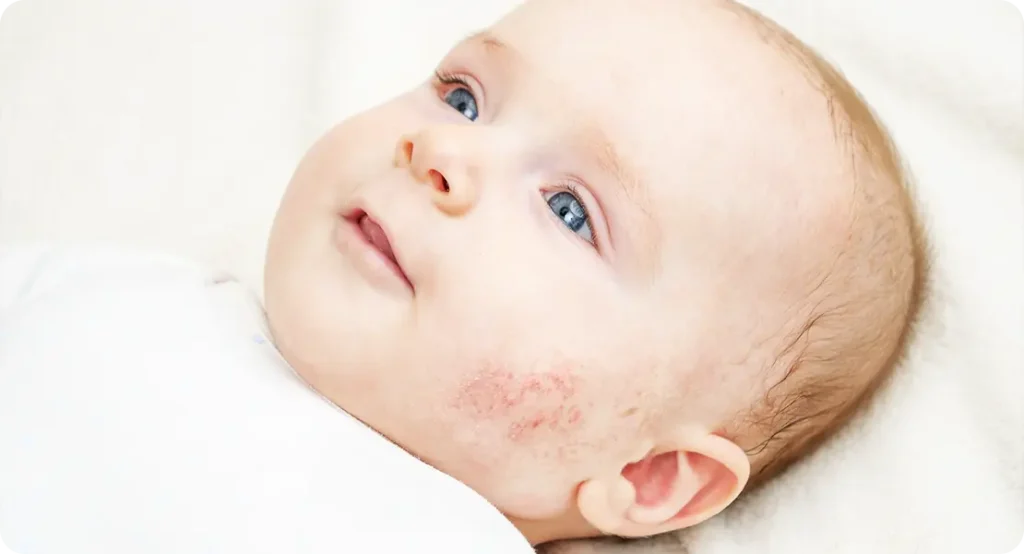
Management of cradle cap primarily focuses on gentle care practices. Regularly washing the infant’s scalp with a mild shampoo can help in softening and removing the scales. Gently massaging the scalp with fingers or a soft brush aids in loosening the flakes, facilitating their removal without causing irritation. For persistent cases, the application of natural oils, such as coconut or olive oil, may be beneficial in softening the scales before washing. If these measures prove ineffective, healthcare providers might recommend medicated shampoos containing antifungal agents or mild topical antifungal creams to address the yeast component. It’s essential to avoid harsh treatments or excessive scrubbing, as the infant’s skin is delicate and can be easily irritated. With appropriate care, cradle cap typically resolves on its own within a few weeks to months, leaving no lasting effects.
7. Pityriasis Alba
Pityriasis alba is a common skin condition predominantly affecting children and adolescents. It presents as round or oval patches of lighter skin, often with fine scaling, primarily on the face, neck, upper arms, and upper torso. The exact cause remains uncertain, but it is often associated with dry skin and may be considered a mild form of eczema. The condition is benign and not contagious, posing no significant health risks. The patches may become more noticeable after sun exposure, as the surrounding skin darkens while the affected areas remain lighter.
Management focuses on alleviating dryness and improving the skin’s appearance. Regular application of moisturisers can help reduce dryness and scaling. In some cases, low-potency topical corticosteroids may be prescribed to decrease inflammation and expedite the return of normal skin pigmentation. Educating patients and caregivers about the harmless nature of the condition is important to address any cosmetic concerns. With appropriate care, pityriasis alba typically resolves on its own over time, and the skin gradually returns to its normal colour.
8. Acne Vulgaris
Acne vulgaris is a widespread skin condition that primarily affects adolescents but can persist into adulthood. It develops when hair follicles become clogged with oil and dead skin cells, leading to the formation of different types of lesions, including comedones (blackheads and whiteheads), papules, pustules, and, in severe cases, nodules and cysts. The condition is often influenced by hormonal changes, particularly during puberty, which stimulate the sebaceous glands to produce excess oil. Other contributing factors include genetics, diet, stress, and certain medications or cosmetic products. Although acne is not a serious medical condition, it can significantly impact self-esteem and mental well-being, especially in teenagers.
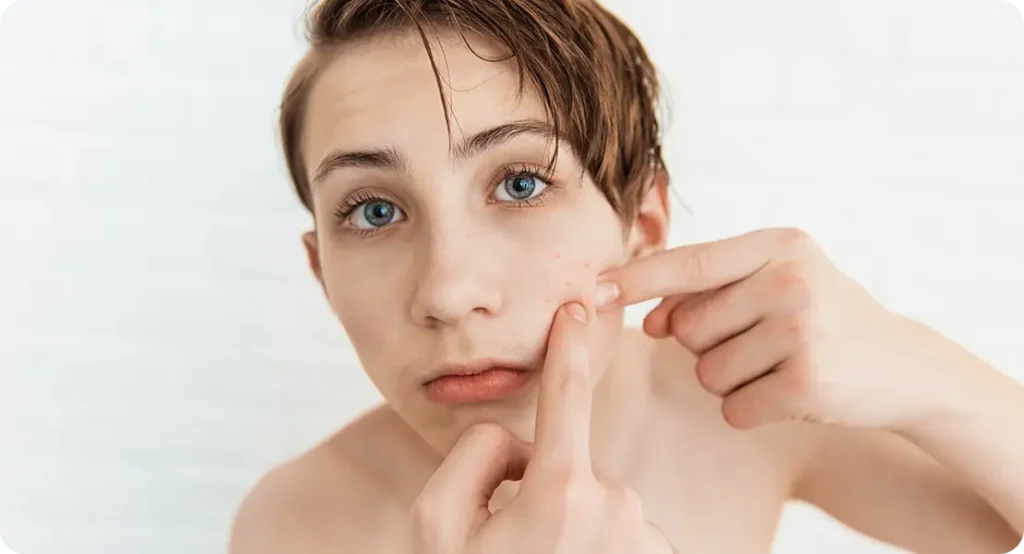
Treatment depends on the severity of the condition and may involve a combination of topical and oral therapies. Mild cases are often managed with over-the-counter treatments containing benzoyl peroxide or salicylic acid to reduce oil production and unclog pores. Prescription-strength topical retinoids, such as adapalene or tretinoin, help to prevent the formation of new blemishes. For moderate to severe cases, oral antibiotics may be prescribed to reduce inflammation, while hormonal therapies, such as oral contraceptives or anti-androgens, can help regulate oil production in females. In the most persistent cases, isotretinoin may be recommended under strict medical supervision. Establishing a consistent skincare routine, maintaining a balanced diet, and avoiding excessive skin irritation can also contribute to better acne management over time.
9. Warts (Verrucae)
Warts are small, rough, non-cancerous skin growths caused by the human papillomavirus (HPV), which infects the top layer of skin. They can appear anywhere on the body but are most commonly found on the hands, feet, and knees. Different types of warts exist, including common warts, plantar warts (on the soles of the feet), flat warts, and periungual warts (around the nails). The virus is highly contagious and spreads through direct skin contact or contact with contaminated surfaces, such as floors in public showers and swimming pools. While warts are generally harmless, they can be unsightly and, in some cases, cause discomfort, especially if located on weight-bearing areas of the feet.
Many warts resolve on their own within months to years as the immune system eventually clears the virus. However, some may persist and require treatment, particularly if they cause pain or spread extensively. Treatment options include over-the-counter salicylic acid preparations, which gradually remove the wart layer by layer, or professional procedures such as cryotherapy (freezing the wart with liquid nitrogen), laser therapy, or electrocautery (burning off the wart). In stubborn cases, immunotherapy may be used to stimulate the body’s immune response against the virus. Preventative measures include avoiding direct contact with warts, wearing protective footwear in communal areas, and keeping the skin dry to reduce the risk of infection.
10. Scabies
Scabies is a highly contagious skin infestation caused by the Sarcoptes scabiei mite, which burrows into the skin to lay eggs. This triggers an allergic reaction, leading to intense itching and a rash consisting of small red bumps, often appearing in clusters. The most affected areas include the wrists, between the fingers, elbows, armpits, waistline, and genitals. The itching tends to worsen at night, disrupting sleep. Scabies spreads through prolonged skin-to-skin contact, making it common in households, schools, and care facilities. While the condition itself is not dangerous, persistent scratching can lead to bacterial infections, such as impetigo.
Effective treatment requires prescription scabicidal creams, such as permethrin or benzyl benzoate, which must be applied to the entire body and left on for the recommended duration before washing off. In some cases, oral medications may be prescribed for severe or widespread infestations. Because scabies spreads easily, all close contacts, including household members, should be treated simultaneously to prevent reinfestation. Bedding, clothing, and towels should be washed in hot water and dried on high heat. Although the mites are eliminated with treatment, itching may persist for a few weeks due to lingering irritation, but antihistamines or soothing lotions can help relieve symptoms.
Conclusion
Recognising common paediatric skin conditions is essential for timely and effective management. While many skin conditions in children are benign and self-limiting, some may require medical intervention. If you have any concerns about your child’s skin, you can contact our experienced dermatologists at The London Dermatology Centre. We are located at 69 Wimpole Street, London, W1G 8AS. To book an appointment or for general enquiries, please call us on 0207 467 3720 or email reception@the-dermatology-centre.co.uk. Our clinic operates Monday to Friday, from 9.00 AM to 5.30 PM.
